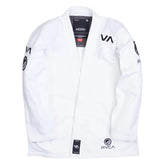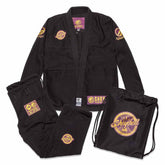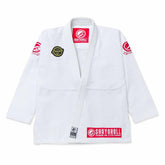BJJ with Gi Explained: What It Means & Which Is Better – Gi or No-Gi?
Brazilian Jiu Jitsu (BJJ) has rapidly gained popularity worldwide. It is attracting practitioners from all walks of life. It does not matter whether you are training for self-defense, fitness or professional competition. BJJ offers a dynamic and rewarding martial arts experience. However, there's an ongoing debate in the BJJ community that often leaves beginners confused: Should you train BJJ with a Gi or No-Gi?
In this article, we will dive deep into both styles—BJJ with Gi and No-Gi BJJ. Moreover, this will highlight their unique characteristics, techniques, benefits, and which might be the better choice for you. Whether you're just starting your BJJ journey or looking to optimize your training, this guide will give you the clarity you need.
What Is BJJ with Gi?
BJJ with a Gi refers to training while wearing a traditional martial arts uniform known as a BJJ Gi or kimono. This uniform consists of a heavy cotton jacket, pants and a belt that signifies your rank. The Gi allows for a wide variety of grips, holds, and submissions. Thus making it a technical and strategic form of training.
Key Features of BJJ Gi Training:
- Grips Galore: You can grip the collar, sleeves, pants, and belt of your opponent. It adds a complex layer of strategy and control.
- Slower Pace: Due to the friction and grip opportunities, Gi training is typically slower and more methodical.
- More Techniques: The presence of the Gi opens up a range of chokes, lapel wraps and control techniques not available in No-Gi.
Popular Techniques in BJJ Gi:
- Cross-collar choke
- Lapel chokes (e.g., Ezekiel choke)
- Spider guard
- Worm guard
- Collar drags
What Is No-Gi BJJ?
No-Gi BJJ is practiced without the traditional Gi uniform. Instead, practitioners wear rash guards, shorts or spats i.e. form-fitting athletic wears. Such active wears minimize friction. This style emphasizes speed, athleticism and different gripping techniques, such as underhooks, overhooks, and body control.
Key Features of No-Gi Training:
- Faster Pace: Without the Gi, the action is quicker and scrambles are more common.
- Grip Limitations: Since you can’t grab clothing, you rely on clinches and natural body grips.
- Focus on Athleticism: No-Gi places a higher emphasis on speed, cardio, and explosiveness.
Popular Techniques in No-Gi BJJ:
- Guillotine choke
- Rear-naked choke
- Arm triangle
- Heel hooks
- Kimura from side control
Gi vs. No-Gi: Which Is Better?
This is the million-dollar question. The answer depends entirely on your goals, body type, training environment and personal preferences. Let’s compare the two across several key aspects:
1- Self-Defense
- Gi Advantage: In real-life scenarios, people usually wear clothing that can be grabbed. Thus, making Gi techniques very applicable.
- No-Gi Advantage: Prepares you for situations where grip-based controls aren’t possible. Such as when someone in a tank top or without a shirt needs to be grabbed.
2- MMA and Grappling
No-Gi is King: Since MMA fighters compete without a Gi, No-Gi BJJ is more relevant to the sport. The fast transitions and limited grip reliance mirror real fight conditions.
3- Technical Development
Gi Wins Here: Gi training slows things down. Thus, allowing for a deeper understanding of leverage, timing and positional control.
4- Athleticism and Cardio
No-Gi Excels: The fast pace and scramble-heavy nature of No-Gi BJJ make it more physically demanding. Hence, it is more reliant on cardiovascular conditioning.
5- Tournaments and Competitions
Both Gi and No-Gi divisions are offered in major competitions like the IBJJF, ADCC, and Grappling Industries. Many high-level athletes compete in both to become more versatile and well-rounded.
Transitioning Between Gi and No-Gi
Many successful Brazilian Jiu Jitsu athletes train in both styles. The skills from each complement one another. Hence, offering a well-rounded grappling game. For example:
- Gi training improves grip strength and technique.
- No-Gi sharpens movement, timing, and explosive power.
Training in both styles can help you adapt to various opponents and situations, whether you are on the mats or in a self-defense scenario.
Which Style Should Beginners Start With?
There is no one-size-fits-all answer, but here are a few pointers:
- Start with Gi if you want to focus on the fundamentals, learn precise techniques, and compete in IBJJF Gi tournaments.
- Start with No-Gi if you are aiming for MMA, enjoy faster-paced rolling, or simply prefer the less restrictive training attire.
- Ultimately, try both and see what resonates with you.
Gear Essentials for BJJ Gi and No-Gi
For Gi BJJ:
- BJJ Gi: Durable, IBJJF-approved, and comfortable
- BJJ Belt: Signifies rank and keeps your Gi in place
- Rash Guard (optional): Often worn under the Gi for comfort and hygiene
For No-Gi BJJ:
- Rash Guard: Moisture-wicking, tight-fitting, and durable
- Grappling Shorts / Spats: No zippers or pockets. Thus, allowing for safe and effective training
Brands like Novakik BJJ offer high-quality Mens IBJJF Ranked Rash Guards and best jiu jitsu gi that are ideal for both beginners and professionals looking for performance and durability.
Final Verdict: Gi or No-Gi?
In the end, Gi and No-Gi Brazilian Jiu Jitsu are two sides of the same coin. Each offers its own set of challenges and advantages and both can dramatically improve your grappling game. It does not matter whether you are chasing gold medals, training for self-defense or just rolling for fun. Incorporating both styles i.e. BJJ with gi and no-gi into your regimen can make you a more complete martial artist.
So, which is better? The best answer might be: Train both. Master both. Become unstoppable.
Start Your BJJ Journey Today
Does not matter whether you are drawn to the tactical grip battles of BJJ Gi or the high-speed scrambles of No-Gi grappling. The world of Brazilian Jiu Jitsu has something incredible to offer you. Suit up, show up, and keep rolling forward.
For premium bjj gear that enhances your performance on the mat, check out Novakik BJJ, your go-to source for BJJ Gis, Ranked Rash Guards, and more.


















